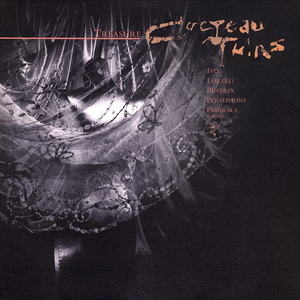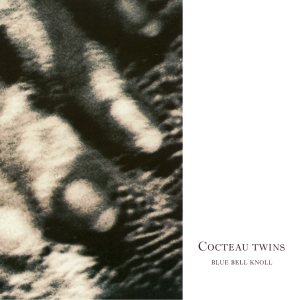Shoegaze is a subgenre of indie and alternative rock characterized by its ethereal mixture of obscured vocals, guitar distortion and effects, feedback, and overwhelming volume. It emerged in Ireland and the United Kingdom in the late 1980s among neo-psychedelic groups who usually stood motionless during live performances in a detached, non-confrontational state. The name comes from the heavy use of effects pedals, as the performers were often looking down at their pedals during concerts.

Cocteau Twins were a Scottish rock band active from 1979 to 1997. They were formed in Grangemouth by Robin Guthrie and Will Heggie (bass), adding Elizabeth Fraser (vocals) in 1981 and replacing Heggie with multi-instrumentalist Simon Raymonde in 1983. The group earned critical praise for their ethereal, effects-laden sound and the soprano vocals of Fraser, whose lyrics often eschew any recognisable language. They pioneered the 1980s alternative subgenre of dream pop and helped define what would become shoegaze.

Head over Heels is the second studio album by Scottish alternative rock band Cocteau Twins. The album was released on 24 October 1983 through the label 4AD. It featured the band's signature sound of "Guthrie's lush guitars under Fraser's mostly wordless vocals" and is considered an archetype of early ethereal wave music.
Slowcore, also known as sadcore, is a subgenre of indie rock characterised by subdued tempos with typically minimalist instrumentation alongside solemn and melancholic lyrical performances.

Heaven or Las Vegas is the sixth studio album by Scottish alternative rock band Cocteau Twins, released on 17 September 1990 by 4AD. Despite 4AD president Ivo Watts-Russell proclaiming it one of the best-ever releases on his label, he released the group from their contract at the end of 1990 because his relationship with the band had soured.

Slowdive are an English rock band that formed in Reading, Berkshire, in 1989. The band consists of Rachel Goswell, Neil Halstead, Christian Savill (guitars), Nick Chaplin (bass), and Simon Scott, all of whom played on the band's debut studio album, Just for a Day (1991). Halstead is the band's primary songwriter.

A.R. Kane was a British musical duo formed in 1986 by Alex Ayuli and Rudy Tambala. After releasing two early EPs to critical acclaim, the group topped the UK Independent Chart with their debut album 69 (1988). Their second album, "i" (1989), was also a top 10 hit. They were also part of the one-off collaboration MARRS, whose surprise dance hit "Pump Up the Volume" was released in 1987. Ayuli is believed to have coined the term "dreampop" in the late 1980s to describe their eclectic sound, which blended elements such as effects-laden guitars, dub production, and drum machine backing.
Morr Music is an independent record label based in Berlin, Germany. It was founded in 1999 by Thomas Morr. Most artists on the label fall into the categories of intelligent dance music, electronica and dreampop, but all reflect Thomas Morr's personal taste. This results in a cohesive aesthetic observable in both the aural and visual elements of this label's releases.

Treasure is the third studio album by Scottish alternative rock band Cocteau Twins, released on 12 November 1984 by 4AD. With this album, the band settled on what would, from then on, be their primary lineup: vocalist Elizabeth Fraser, guitarist Robin Guthrie and bass guitarist Simon Raymonde. The album also reflected the group's embrace of the distinctive ethereal sound they became associated with.
Popular music of the United Kingdom in the 1990s continued to develop and diversify. While the singles charts were dominated by boy bands and girl groups, British soul and Indian-based music also enjoyed their greatest level of mainstream success to date, and the rise of World music helped revitalise the popularity of folk music. Electronic rock bands like The Prodigy and Chemical Brothers began to achieve a high profile. Alternative rock reached the mainstream, emerging from the Madchester scene to produce dream pop, shoegazing, post rock and indie pop, which led to the commercial success of Britpop bands like Blur and Oasis; followed by a stream of post-Britpop bands like Radiohead and The Verve.

Blue Bell Knoll is the fifth studio album by Scottish alternative rock band Cocteau Twins, released on 19 September 1988 by 4AD. This was the band's first album to receive major-label distribution in the United States, as it was originally licensed by Capitol Records from 4AD for North American release. After a period of being out of print while 4AD reclaimed the American distribution rights for their back catalogue, the album was remastered by guitarist Robin Guthrie and reissued in 2003. Vocalist Elizabeth Fraser named the album after a peak in southern Utah called Bluebell Knoll.

Colm Ó Cíosóig is an Irish musician, best known as the drummer for the alternative rock band My Bloody Valentine, of which he was a founding member.
Ethereal wave, also called ethereal darkwave, ethereal goth or simply ethereal, is a subgenre of dark wave music that is variously described as "gothic", "romantic", and "otherworldly". Developed in the early 1980s in the UK as an outgrowth of gothic rock, ethereal wave was mainly represented by 4AD bands such as Cocteau Twins, This Mortal Coil, and early guitar-driven Dead Can Dance.
"All I Wanna Do" is a song by the American rock band the Beach Boys from their 1970 album Sunflower. Written by Brian Wilson and Mike Love, the dreamlike production quality was created through liberal use of overdubbing, reverb and delay effects. It was influential to the development of lo-fi music and pioneered sounds that became associated with the shoegaze, dream pop, and chillwave music genres.

Quique is the debut album by British music group Seefeel. It was released through Too Pure in October 1993. A predominantly instrumental record which utilises elements of both rock and electronic music, it blends styles including techno, dream pop, ambient, and dub. Guitarist Mark Clifford worked continually on tracks while other members either completed them or provided component ideas.
Burnt Hair Records was a record label involved with Michigan's space rock alternative music scene in the 1990s. The label is said to have been most responsible for cultivating the Detroit sound of this period. Burnt Hair recorded artists in various experimental genres also known by appellations such as indie pop, indie rock, ambient music, drone music, dream pop and electronica. The label was founded by Larry Hofmann in Dearborn. Burnt Hair released recordings by artists and bands including Windy & Carl, Hopewell, Mahogany, Ten Second Dynasty, Miss Bliss, Tomorrowland, DELTA WAVES, Starphase 23, Füxa, Auburn Lull, Monaural (Band), Gravity Wax, Asha Vida, Flowchart and Alison's Halo.

69 is the debut album by British band A.R. Kane, released in 1988 on Rough Trade Records and produced by the band with additional co-production from Ray Shulman. Following the release of their acclaimed Lollita and Up Home! EPs, 69 developed the experimental "dream pop" style pioneered by the duo, blending elements of dub, acid rock, jazz, noise, and pop.

Scar is a mini album by English rock band Lush. It was released on 9 October 1989 on 4AD. Originally intended to be a three-track single release, Scar was produced by John Fryer and the band themselves and recorded at London's Blackwing Studios in 1989.
The Veldt is a pioneering alternative soul and shoegaze group formed in 1986 in Raleigh, North Carolina by identical twin brothers Daniel and Danny Chavis. The band took their name from a Ray Bradbury science fiction story. After signing with Capitol Records in 1989, the group went on to tour America opening for such groups as The Jesus and Mary Chain and the Cocteau Twins, whose member Robin Guthrie produced their initial recordings. Their 1994 album 'Afrodisiac' is viewed as a classic of the shoegaze genre.











